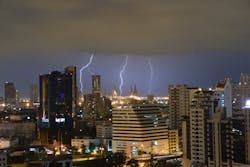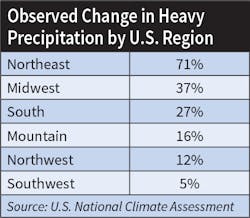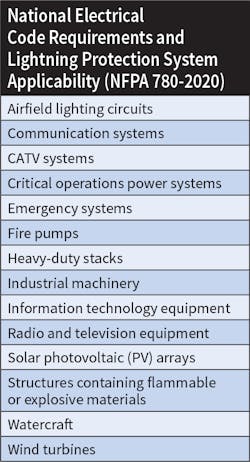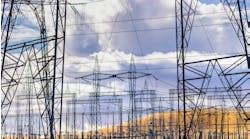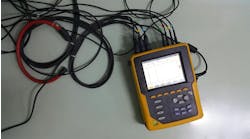When a 2018 lightning strike knocked out power at New York’s Good Samaritan Hospital Medical Center, operating room humidity controls failed. As a result, the hospital was forced to postpone dozens of surgeries.
That Level II trauma center is not alone. Flashes of bad luck have recently inflicted damage to hospital electrical cables, generators, and information communications technology. Extreme events include a 2017 lightning strike at a Florida hospital — where a fire led to widespread failure of the back-up power systems. Within six hours, the hospital transferred all 225 patients.
As climate change raises temperatures and produces more extreme storms, regions previously unaccustomed to lightning activity are now experiencing a greater number of strikes. The potential for damage is particularly concerning for critical facilities (like hospitals) in certain regions where most existing buildings do not have a lightning protection system (LPS). Left unprepared, a power surge could pose serious risks to patient care.
Warmer weather, greater risks
When or where lightning will strike is unpredictable. Nevertheless, climate researchers have drawn connections between surface temperatures, precipitation rates, and lightning flashes — suggesting more lightning can be expected in the years ahead.
As temperatures warm, heavy precipitation events are likely to become more common, changing electrical balance in the air and causing lightning to strike. A study published in the journal Science concluded that every 1ºC rise in global temperatures will result in a projected 12% increase in lightning strikes.
The growing threat to buildings and other structures may already be real. Compared to the prior decade, from 2011 to 2020 the United States experienced a 40% increase in property damage events caused by lightning strikes, according to U.S. National Oceanic and Atmospheric Administration data. Lightning events often go unreported, especially from years back. Still, many building owners – hospitals included – are noticing an increase.
While protection systems are common in newly constructed hospitals, older facilities are more often left vulnerable. A growing number of insurers are insisting on their installation.
Dangers from direct and indirect lightning strikes
Health-care settings are particularly vulnerable to lightning damage. Sensitive electronic equipment includes imaging systems, patient monitoring devices, electronic record keeping, and more. Highly explosive materials (such as oxygen tanks) could pose fire risks if left unprotected.
When lightning surges enter a building, it travels through any conductive material — be it wiring, communications systems, cable television (CATV) systems, or broadband communications systems. Without an LPS, surges are likely to blow through the electrical system and temporarily knock out power.
Problems can remain even after restoring the power supply, restarting servers, and rebooting other electrical systems. Lightning-struck hospitals have reported that surveillance cameras, badge readers, and fire alarm systems needed to be repaired. Following a strike, patient attendance systems and “code blue” resuscitation alarm buttons may also not function as designed.
Regardless of whether a hospital experiences a direct strike, lightning nearby poses dangers, too. Indirect strikes can result in an overvoltage between structure foundations and the building’s power lines, or radiating voltage can travel from as far as several hundred yards away.
A Level I trauma center recently reported that a back-up generator repeatedly failed routine checkups due to improper integration with the hospital’s LPS. Area thunderstorms caused enough transient voltage to likely cause the equipment failure.
Lightning protection best practices
In recent years, advances in LPS design and surge protective devices (SPDs) have significantly prevented damage and helped to save lives. The challenge is to develop a whole-building approach. In an interconnected system, the LPS establishes a low-impedance path for lightning’s electrical currents to reach the ground, while SPDs limit transient voltages and work to divert surge currents away from electrical equipment and toward the grounding system.
The design process begins with a site-specific study to determine the appropriate choice of air terminals (previously known as lightning rods), as well as to identify locations that best capture and redirect the lightning surge.
A system of grounded conductors is laid from the rooftop across the exterior of the building. Several aluminum or copper rods channel lightning to eventually reach the ground where its energy dissipates. Conductors are kept as short and direct as possible to minimize the risk of failure. Best practice is to avoid installation in gutters or downpipes to prevent corrosion of the down conductors. The wires that make up the “earth termination system” are usually placed a few feet away from the building.
Once installed, the LPS must be bonded to the building’s electrical system, mechanical structures, and all external conductive components. Known as “equipotential bonding,” this process offers internal lightning protection by preventing dangerous sparking events.
Conductive parts that must be integrated with the equipotential bonding system include:
- earthing conductors,
- lightning protection earth electrodes,
- conductive parts of the building structures,
- earthing conductors for antennas, and
- metal shields of electrical and electronic conductors.
If voltage from a nearby lightning strike reaches the building, simple fuses and circuit breakers offer a poor defense. Instead, SPDs monitor external and internal system voltages and activate when a transient voltage occurs on the circuit. After diverting the transient back to its source or the ground, the SPD resets to a high-impedance state.
Lightning protection code requirements
NFPA 70, National Electrical Code (NEC), and NFPA 780, Standard for the Installation of Lightning Protection, do not require lightning protection at all types of facilities or for all building structures. However, the number of systems that need to be protected has increased in recent iterations.
Protection designs must adhere to Underwriter Laboratories’ UL 96A, the definitive standard for lightning protection system installation requirements. UL 96A addresses air terminals, cable conductors, fittings, connections, and fasteners.
In addition, hospitals are encouraged by NFPA 780, NFPA 70, and the Facilities Guidelines Institute (FGI) to develop risk assessments and mitigation plans for weather events such as lightning strikes. Considerations when undertaking a safety risk assessment include the potential of lightning damage on:
- communications, fire-alarm, and radio systems;
- electronic medical records (EMR) and other IT systems;
- evacuation procedures;
- heating, ventilation, and air conditioning (HVAC) systems;
- patient-monitoring systems and pharmaceutical-dispensing devices;
- power supplies and back-up generators;
- roof and structural systems; and
- security and safety systems.
Heightened vulnerability, growing risks
Lightning contains up to one billion volts of electricity and produces heat estimated to be up to five times hotter than the surface of the sun, according to the National Weather Service. As the United States braces for heavier and more frequent rainstorms, some regions must also prepare for an increase in lightning strikes. Although thunderstorms are more common in southern states, health-care facilities in the rest of the country may be less likely to have fully operational and properly maintained protections.
To determine the protection needs for any facility, Annex L of NFPA 780 offers a lightning risk assessment. In general, this standard recommends LPS installations on structures where vulnerability exceeds the facility’s tolerable risk. For many health-care facilities, risk assessments will likely conclude that the costs of a potential lightning strike are too risky to bear. The increasing use of sensitive electronic systems and Internet of Things (IoT) devices make robust LPS and SPD systems even more imperative.
If misfortune strikes, it will be the proactive hospitals that can withstand a storm event. Along with advanced emergency back-up power systems, hospitals should consider LPS and SPD upgrades to ensure full operations at times when patients and community members rely on these systems the most.
Joseph Mizrahi, P.E., is a vice president at Burns Engineering in New York. He leads the New York office and is a nationally respected provider of specialized engineering services, bringing highly technical, sought-after expertise for complex transportation and critical infrastructure projects. He can be reached at [email protected].

